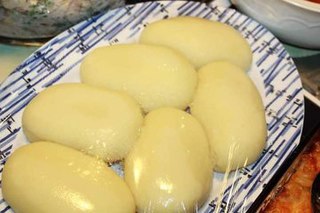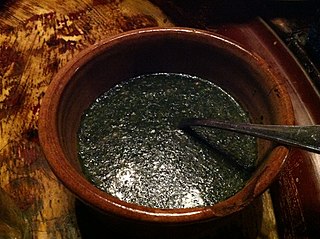
Malay cuisine is the traditional food of the ethnic Malays of Southeast Asia, residing in modern-day Malaysia, Indonesia, Singapore, Brunei, Southern Thailand and the Philippines as well as Cocos Islands, Christmas Island, Sri Lanka and South Africa.

Fufu is a pounded meal found in West African cuisine. It is a Twi word that originates from the Akans in Ghana. The word has been expanded to include several variations of the pounded meal found in other African countries including Sierra Leone, Guinea, Liberia, Cote D'Ivoire, Burkina Faso, Benin, Togo, Nigeria, Cameroon, the Democratic Republic of Congo, the Central African Republic, the Republic of Congo, Angola and Gabon. It also includes variations in the Greater Antilles, where African culinary influence is high.

Ẹ̀bà (Yoruba) also known as Ebe or Pinon' is a staple swallow from Togo and Benin, also eaten in the West African sub-region and other African countries. The term èbà originates from Yoruba. It is also called utara by the Igbo people of southeast Nigeria. It is a cooked starchy vegetable food made from dried grated cassava (manioc) flour commonly known as garri all across West Africa. It is often eaten with rich soups and stews, with beef, stockfish or mutton. The dish is often described as having a slightly sour, sharp taste.

Cameroonian cuisine is one of the most varied in Africa due to Cameroon's location on the crossroads between the north, west, and center of the continent; the diversity in ethnicity with mixture ranging from Bantus, Semi-bantus and Shuwa Arabs, as well as the influence of German, French and English colonialization.

The cuisine of the Democratic Republic of the Congo and the Republic of the Congo varies widely, representing the food of indigenous people. Cassava, fufu, rice, plantain and potatoes are generally the staple foods eaten with other side dishes.

Mulukhiyah, also known as molokhiyya, melokhiyya, or ewedu, is a type of jute plant and a dish made from the leaves of Corchorus olitorius, commonly known in English as jute, jute leaves, jute mallow, nalta jute, or tossa jute. It is used as a vegetable and is mainly eaten in Egypt, the Levant, Sudan, Cyprus, Libya, Tunisia and Algeria. It is called saluyot in the Philippines. Mulukhiyah is rather bitter, and when boiled, the resulting liquid is a thick, highly mucilaginous broth; it is often described as "slimy", rather like cooked okra. Mulukhiyah is generally eaten cooked, not raw, and it is either eaten chopped and sautéed in oil, garlic and cilantro like in Syria or turned into a kind of soup or stew like in Egypt, typically bearing the same name as the vegetable in the local language. Traditionally mulukhiyah is cooked with chicken or at least chicken stock for flavor and is served with white rice, accompanied with lemon or lime.

Ghanaian cuisine refers to the meals of the Ghanaian people. The main dishes of Ghana are centered around starchy staple foods, accompanied by either sauce or soup as well as a source of protein. The primary ingredients for the vast majority of soups and stews are tomatoes, hot peppers, and onions. As a result of these main ingredients, most Ghanaian soups and stews appear red or orange.

Peanut stew or groundnut stew, also known as maafe, sauce d'arachide (French) or tigadèguèna is a stew that is a staple food in Western Africa. It originates from the Mandinka and Bambara people of Mali.

West African cuisine encompasses a diverse range of foods that are split between its 16 countries. In West Africa, many families grow and raise their own food, and within each there is a division of labor. Indigenous foods consist of a number of plant species and animals, and are important to those whose lifestyle depends on farming and hunting.

Nigerian cuisine consists of dishes or food items from the hundreds of Native African ethnic groups that comprises Nigeria. Like other West African cuisines, it uses spices and herbs with palm oil or groundnut oil to create deeply flavored sauces and soups.

Javanese cuisine is the cuisine of Javanese people, a major ethnic group in Indonesia, more precisely the province of Central Java, Yogyakarta and East Java.

Sundanese cuisine is the cuisine of the Sundanese people of Western Java, and Banten, Indonesia. It is one of the most popular foods in Indonesia. Sundanese food is characterised by its freshness; the famous lalab eaten with sambal and also karedok demonstrate the Sundanese fondness for fresh raw vegetables. Unlike the rich and spicy taste, infused with coconut milk and curry of Minangkabau cuisine, the Sundanese cuisine displays the simple and clear taste; ranged from savoury salty, fresh sourness, mild sweetness, to hot and spicy.

Beninese cuisine involves many fresh meals served with a variety of sauces. Meat is usually quite expensive, and meals are generally light on meat and generous on vegetable fat.

Central African cuisine includes the cuisines, cooking traditions, practices, ingredients and foods of the Central African Republic (CAR). Indigenous agriculture in the country includes millet, sorghum, banana, yam, okra, yellow onion, garlic, spinach, rice and palm oil. Imported crops of American origin include maize, manioc (cassava), peanuts, chili peppers, sweet potato and tomato. Additional foods include onions, garlic, chiles and peanuts.

Bazin (Arabic: البازين, pronounced, is an unleavened bread in the cuisine of Libya prepared with barley, water and salt. Bazin is prepared by boiling barley flour in water and then beating it to create a dough using a magraf, which is a unique stick designed for this purpose. The dough may then be placed in a pan and allowed time to harden, after which it is baked or steamed. The salt contributes to the hardness of the bazin. Bazin may have a paste-like and hardened texture. It may also be prepared using whole wheat flour, olive oil and pepper as ingredients.

Madurese cuisine is the culinary tradition of the Madurese people from Madura Island in Indonesia. This cuisine is particularly well-known in the neighboring areas of East Java, as well as on the south coast of Kalimantan. As a leading salt production center in the Indonesian archipelago, Madurese dishes are often saltier compared to Eastern Javanese cuisine, although with significant Javanese influences.

Indonesian noodles are a significant aspect of Indonesian cuisine which is itself very diverse. Indonesian cuisine recognizes many types of noodles, with each region of the country often developing its own distinct recipes.

Indo cuisine is a fusion cooking and cuisine tradition, mainly existing in Indonesia and the Netherlands, as well as Belgium, South Africa and Suriname. This cuisine characterized of fusion cuisine that consists of original Indonesian cuisine with Eurasian-influences—mainly Dutch, also Portuguese, Spanish, French and British—and vice versa. Nowaday, not only Indo people consume Indo cuisine, but also Indonesians and Dutch people.
Sombe also known as Cassava leaves stew is a type of stew native to the Bakonzo in Uganda and also in the Eastern DRC, Burudians, Banyarwanda. It is traditionally made from freshly mashed cassava leaves as the main ingredient mixed with either fish or ground nuts paste or any type of meat such as beef, goat's meet, pork. Sombe is served majorly with Bundu (also known as mingled Tapioca, Kalo, fufu but it can also be served with rice, posho, matooke, Ggonja.


















